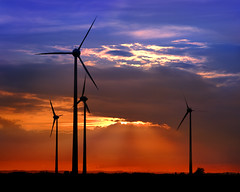 A ridiculous premise? Of course! But that's the argument you often hear people make against wind power. When it's not windy, it doesn't produce as much power! You are correct, Mr. Wizard. I can't wait to hear your analysis of how much power solar produces on cloudy winter days. (Spoiler alert: Not as much!)
A ridiculous premise? Of course! But that's the argument you often hear people make against wind power. When it's not windy, it doesn't produce as much power! You are correct, Mr. Wizard. I can't wait to hear your analysis of how much power solar produces on cloudy winter days. (Spoiler alert: Not as much!)Here's the thing -- just as no one plugs their television directly into a nuclear reactor, no one plugs their television directly into a windmill. It's just one element of a massive electric grid.
But that doesn't stop people from acting like they've cracked some major conspiracy every time they point that out. Just look at a recent public hearing on the proposal by Dominion Power & BP Wind Energy to install wind turbines on top of East River Mountain in Tazewell County:
“It produces very little energy and it’s very unreliable,” said Charlie Stacy.A power plant produces very little power? Really? I made many arguments against Dominion's Wise County coal fired power plants in the last few years, but "it produces very little energy" is one that never crossed my mind. Probably because it's beyond batty. Why bother building a reservoir? It produces very little water!
As for reliability, just as with tourism, you have to look at the big picture. A wind farm is part of a grid, which includes a mix of energy from an array of sources like coal, nuclear, natural gas, hydroelectric, solar & other sources.
Good day for wind? A nuclear plant can throttle back for the day. Bad day for wind? If demand's low on a given day, the grid may not miss it. If demand is high, a natural gas plant could work closer to capacity to make up the difference. (There's a misconception that all existing coal/gas/nuke plants work at 100% day & night. Not true except on a few of the hottest summer days.)
Or better yet, a smart grid could manage it. On good days, it could direct the excess electricity to other parts of the country where it was in demand. On bad days, it could pull more power from a part of the country where the wind was blowing strong. The bottom line is, customers wouldn't notice a thing.
If you've found all this energy nitty gritty fascinating, buy Al Gore's new book, Our Choice: A Plan to Solve the Climate Crisis.
Photo courtesy Flickr's floyduk

1 comment:
The dispatch order onto the grid is, first, renewables (by federal law), then nukes (keep 'em running), then further baseload coal, gas, etc. So, by increasing renewables, we displace fossil-fueled generation which is a good thing. The marginal impact of renewables on carbon and criteria pollutant emissions is stronger than just the average emission factor for the grid.
Post a Comment